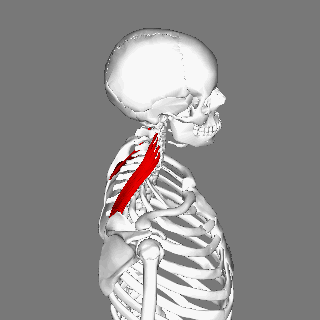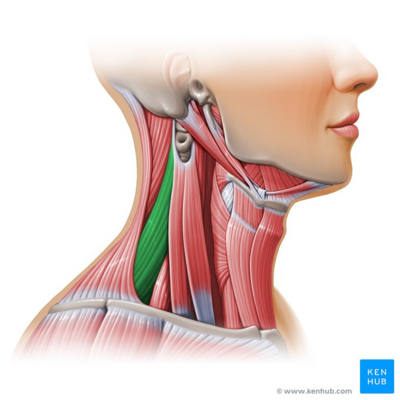Levator Scapulae
Original Editor - Wendy Walker
Top Contributors - Eric Henderson, SULEIMAN USMAN, Kim Jackson, Lucinda hampton, Admin, Wendy Walker, WikiSysop, Evan Thomas, Oyemi Sillo, Tarina van der Stockt and Joao CostaDescription[edit | edit source]
Levator scapulae is a posterior Axio-appenducular muscle that connects the upper limb to the vertebral column and lies in the posterior triangle of the neck. The superior aspect of the levator scapulae is covered by sternocleidomastoid, and its inferior part by trapezius.[1]
Image: Levator scapulae muscle (highlighted in green) - lateral view [2]
Origin[edit | edit source]
The levator scapulae originates on the posterior tubercle of transverse process of cervical vertebrae 1 to 4.[3]
Insertion[edit | edit source]
The levator scapulae inserts on to the vertebral margin of the scapula between the superior angle and the root of the spine.[4]
Position[edit | edit source]
The superior third of the strap-like levator scapulae lies deep to the sternocleidomastoid while the inferior third is deep to the trapezius. From the transverse processes of the upper cervical vertebrae, the fibers of the levator of the scapula pass inferiorly to the superomedial border of the scapula.[1]
Nerve Supply[edit | edit source]
The levator scapulae is innervated by cervical nerve (C3-C4) and dorsal scapular nerve (C5).[5]
Blood Supply[edit | edit source]
Descending scapular artery[6]
Function[edit | edit source]
The levator scapulae functions to elevate the scapula and tilt the glenoid cavity inferiorly by rotating the scapula downward. [7]
If the scapula is fixed, a contraction of the levator scapulae leads to the lateral flexion of the cervical vertebral column to the side and stabilizes the vertebral column during rotation.<section> If the cervical spine is fixed the levator scapulae muscle helps in elevating and rotating the scapula such that the lateral angle moves inferiorly (i.e., rotates the point of the shoulder down).
When the scapula is stabilized, contraction of this muscle laterally flexes and rotates the neck to the same side.
Bilateral contraction helps in extension of the cervical spine[8] </section>
Clinical Relevance[edit | edit source]
Forward head posture puts increased tension on the levator scapulae muscles to co-contract for cervical extension in an elongated position.[9] Increased tightness in the levator scapulae due to increased activity from a forward head posture can lead to cervicogenic headaches.
Assessment[edit | edit source]
The levator scapulae length and tension can be assessed by placing the patient in supine, stabilizing the ipsilateral scapula, and contralateraly side bend and rotate the head. Also, trigger points are common in this muscle and can be palpated for in both the superior attachment and inferior attachment.
Treatment[edit | edit source]
Pain or discomfort caused by the levator scapulae can be relieved by various modalities and active movements to provide relief.
References[edit | edit source]
- ↑ 1.0 1.1 Keith, L., Arthur, F. and Anne, M. (n.d.). Moore Clinically Oriented Anatomy. 7th ed.
- ↑ Levator scapulae muscle (highlighted in green) - lateral view image - © Kenhub https://www.kenhub.com/en/library/anatomy/levator-scapulae-muscle
- ↑ http://www.anatomyexpert.com/structure_detail/5502/
- ↑ Marieb EN, Hoehn K. Human anatomy & physiology. 10th ed. Boston, Ma: Pearson; 2016.
- ↑ Gray, Henry. Anatomy of the Human Body. Philadelphia: Lea & Febiger, 1918; Bartleby.com, 2000. www.bartleby.com/107/121.html
- ↑ Joseph P Iannotti, Richard Parker.fckLRThe Netter Collection of Medical Illustrations: Musculoskeletal System, Volume 6, Part I - Upper Limb. Elsevier Health Sciences. 2012
- ↑ Paine R, Voight ML. The role of the scapula. International journal of sports physical therapy. 2013 Oct;8(5):617. Available from: https://www.ncbi.nlm.nih.gov/pmc/articles/PMC3811730/ (last accessed 30.1.2020)
- ↑ science direct Levator Scapular muscle Available from: https://www.sciencedirect.com/topics/medicine-and-dentistry/levator-scapulae-muscle (last accessed 30.1.2020)
- ↑ Kim E-K, Kim JS. Correlation between rounded shoulder posture, neck disability indices, and degree of forward head posture. J Phys Ther Sci [Internet]. 2016 Oct [cited 2018 Jul 4];28(10):2929–32. Available from: https://www.ncbi.nlm.nih.gov/pmc/articles/PMC5088155/








